13 Acoustic Weapons
By Professor Randall K. Nichols, Professor Candice M. Carter, Dr. Robert McCreight
Student Learning Objectives
- The student will take a brief sojourn into the science of audiology to understand why acoustic countermeasures work.
- The student will explore acoustic countermeasures against hostile UAS (especially Swarms) and their dual use as Identify Friend or Foe (IFF) vectors for UAS characterization.
- The student will learn about Havana Syndrome.
- The student will be re-introduced to the problem of countering hostile use of UAS, UV / Unmanned boats / UUV against US national defense interests. This chapter focuses on the Spratlys, a tiny set of islands in the South China Seas. The Spratlys are at the forefront of China’s military expansion and control program (Corr, 2018). In this tiny island sanctuary, drones and unmanned boats are the intelligence weapons of choice. Intrusions on US capital ships have already begun and could escalate to become the flashpoint for WW III.[1] The focus will be on the use of acoustic weapons at short range
- The student will be updated on suspicious drone use by China for ISR missions in the South China Seas in light of the Russian invasion of Ukraine and China’s signals that Taiwan might suffer the same fate.
- The concept of the Screamer will be postulated.
Disclaimer
This chapter represents a review of material in Chapter 19 of our Unmanned Aircraft Systems in the Cyber Domain, 2nd Edition. (Nichols & Mumm, Unmanned Aircraft Systems in the Cyber Domain, 2nd Edition., 2019). It also updates original research into drone use by China in the South China Seas (SCS) by the authors, which became the basis for Chapters 9, 12, & 14 in our recent textbook Unmanned Vehicle Systems & Operations on Air, Sea & Land. (Nichols & Ryan, Unmanned Vehicle Systems & Operations on Air, Sea & Land, 2020).
In addition, the authors will cover the relation of sound to the Havana Syndrome and, finally, detail an update in the SCS of suspicious drone incidents. (Neo, Aerial, and UUV suspicious drone incidents in the SCS, 2019-2022) Chapter 15 in this textbook will cover Cyber Weapons and CBRN critical infrastructure facilities. Permissions of the Wildcat writing team, managing editor, and copyright holders have been received.
Detection Signatures Review
Recall from Chapter 8 Stealth, in the author’s textbook Unmanned Aircraft Systems in the Cyber Domain, 2nd Edition, (Nichols & Mumm, Unmanned Aircraft Systems in the Cyber Domain, 2nd Edition., 2019) that their signatures detect UAS / UAVs: noise (acoustic), optical (visible), infrared (thermal) and radar (radio). “These acoustic or electromagnetic emissions occur at the following wavelengths: (Austin, 2010)
- A) Noise (acoustic) [16 m-2 cm, or 20 – 16000 Hz]
- B) Optical (visible) [0.4 – 0.7 um]
- C) Infrared (thermal) [0.75 um – 1 mm]
- D) RADAR (radio) [3 mm – 3 cm]” (Austin, 2010)
In the discussion on stealth, it was presented that “If the designer is to reduce the vehicle detectability to an acceptable risk level, it is necessary to reduce the received emissions or reflection of the above wavelengths (expressed as frequencies) below the threshold signature value. A good portion of the UAS signatures is a function of the operating height of air vehicle.” (Austin, 2010) The concept of frequency as a fifth realm was elucidated in terms of targets, battlespace, and wavelengths. One of the parameters, range, was a serious limitation on performance. The range has a significant impact on radio transmission. Depending on the environment, the strength of a received signal, T, is a function of the square or fourth power of a distance, d, from the transmitter. (Adamy D. -0., 2015) The EMS was presented with emphasis on sound frequencies, many out of human hearing range. The UAS designer’s upper end of noise – Stealth acceptability is 17,150 Hz. The full Stealth range is 20 Hz – 17,150 Hz.
Essentials of Audiology
Why would a UAS going at 100 mph or more be susceptible to a loud noise hitting the MEMS under the UAS rotors or the rotors themselves? Additionally, why would this same noise or variation thereof be capable of characterization the UASs as a hostile or friendly power? It is not something we can just take for granted without understanding the essentials of audiology underlying the process.
Audiology Fundamentals
The science of sound is called acoustics, a branch of physics. Table 13.1 displays the principal physical quantities in MKS, cgs, and English units. Table 13.1 can be found in most engineering, physics, or medical textbooks. (Entokey, 2019) It is the starting point of a trip uphill to resonance frequencies.
Table 13.1: Principal Physical Properties (Entokey, 2019) and (Gelfand S. A., 2009)
| Quantity | Formula | MKS (SI.)Units | Cgs Units | Comments | English Units |
| Mass (M) | M | kilogram (kg) | gram (g) | 1kg = 103 g
1kg = 2.2046 lbs |
pounds (lbs) |
| Time (t) | t | seconds, (s) | s | s | |
| Area (A) | A | m2 | cm2 | 1 m2 = 104 cm2 | ft2 |
| Displacement (d) | d | meter (m) | centimeter (cm) | 1m = 102 cm | ft |
| Velocity (v) | v = d/t | m/s | cm/s | 1 m/s = 102 cm/s | ft/s |
| Acceleration (a) | A = v/t | m/s2 | cm/s2 | 1 m/s2 = 102 cm/s2 | ft/s2 |
| Force (F) | F = MA = Mv/t
Mv = Momentum |
kg x m/s2
newton (N) |
g x cm2
dyne
|
1N = 105 dynes | 1lbf = 1 lb x 32.174049 ft -lbs /s2 = 9.80665 m/s2 |
| Pressure (p) | p = F/ A | N /m2
Pascal (Pa) |
dynes /cm2
microbar (µbar) |
20 µPa = 2 x 10-5 N/m2
reference value |
Psi = lbf /in2
1 N/m2 = 0.000145 psi
|
| Work (W)
|
W =Fd | N x m
Joule
|
dyne x cm
erg |
1 j = 107 erg/s
Energy -capability to do Work. Potential energy for a body at rest and kinetic energy for a body in motion. |
BTU
[British Thermal Unit] 1BTU = 1055.056 joules |
| Power (P) | P = W/t =
Fd/t =Fv |
Joules/s
watt (w) |
erg/s
watt (w) |
1 w = 1 J/s = 107 erg/s | 1 watt = 3.412 BTU/hr |
| Intensity (I) | I = P/A
I = P / 4ℼr2 Based on sphere radius
|
w/m2 | w/cm2 | 10-12 w/m2
reference value |
Sources: (Entokey, 2019) and (Studios, 2017)
Figure 13.1: Inverse Square Law, Sound Intensity
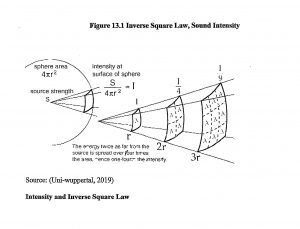
Source: (Uni-wuppertal, 2019)
The intensity and Inverse Square Law
“Sound radiates outward in every direction from its source. This constitutes a sphere that gets larger and larger with increasing distance from the source.” (Entokey, 2019) Figure 13.1 shows the relationship between Intensity and the Inverse Square Law. (Uni-wuppertal, 2019) Intensity (I) (power divided by area) decreases with distance from the original source because a finite amount of power is spread over increasing surface area. (Entokey, 2019) Proportionately less power falls on the same unit of area with increasing distance from the source. (Gelfand, 2004)
“Four important and understandable relationships to note are that power is equal to pressure squared, P = p2, pressure is equal to the square root of power, p = √ P, intensity is proportional to pressured squared, I ≈ p2, and pressure is proportional to intensity, p ≈ √I. This makes it easy to convert between sound intensity and sound pressure.” (Entokey, 2019) These relations yield a few more to relate sound pressure, sound intensity, and distance r. Given to pressures p1 and p2 at distance r1 and r2, they are proportional: p2 / p1 = r1 / r2; and factoring in intensities at I1 and I2, gives I2 / I1 = (r1 /r2)2.
Finally, r2 / r1 = p2 / p1 = √I1 / I2. (TRS, 2018)
Decibels (Adamy D. , 2001) (Gelfand S. A., 2009)
Sound magnitudes, intensities, and pressures vary over an enormous range. We use decibels (dB) to express sound values. Decibels takes advantage of ratios and logarithms. Ratios are used so that physical magnitudes can be stated in relation to a reference value that has meaning to us. The reference point chosen is the softest sound that normal people can hear. The reference value has an intensity of 10-12 w/m2 (10-16 w/cm2). In terms of sound pressure, the reference value is: 2 x 10-5 N/m2 or 20 µPa (2 x 10-4 dynes/cm2). An interesting Geek bar bet is what is the logarithm of all 2:1 ratios, 8:4, 20, 20:10, 100:50, etc.? Even though the distance between absolute numbers gets wider, 1,4,10, 50…, the logarithms of the 2:1 ratios are the same at 0.3. Another interesting factoid about ratios is that the units generally cancel out.
The general decibel formula in terms of power level (PL) is as follows (Gelfand, 2004):
PL = 10 log P / Po Equation 13.1
Where P = power of the sound measured, and Po is the reference power to be compared.
The general decibel formula in terms of power level (IL) is as follows (Gelfand, 2004):
IL = 10 log I / Io Equation 13.2
Where I = intensity of the sound measured, and Io is the reference intensity to be compared. Io is given as 10-12 w/m2.
The general decibel formula for sound pressure level (SPL) is obtained by replacing all of the intensity values with the corresponding values of pressure squared because (I ≈ p2).
SPL = 10 log p2 / po2 Equation 13.3
Where p is the measured sound pressure (in N/m2) and po is the reference sound pressure of
2 x 10-5 N/m2 . A more convenient form of this equation recognizes that log x2 = 2 log x. (Gelfand, 2004)
SPL = 20 log p / po Equation 13.4
Equation 13.4 is the common formula for SPL. A positive decibel value means that the sound pressure level is greater than the reference. The decibel value of the reference is 0 because reference value / reference value = 1 and 10 log 1 = 0. This does not mean any sound; it means the sound measured equals the reference point. A negative value of decibels means that the sound magnitude is lower than the reference. (Gelfand S. A., 2009)
Figure 13.2 shows common decibel and Intensity levels within the hearing range. This does not consider the environment, frequency differences, or noise (discussed presently). It does show the ease with which decibels may be used to rank the sound intensity levels, which vary greatly in magnitude. [2]Hearing aids are effective from about 6 – 90 decibels. Above 90 dB, they can dampen but not eliminate the very loud sounds unless there is a complete loss of hearing.
Figure 13.2 shows common decibel and Intensity levels within the hearing range

Source: (slideshare.net, 2019)
The Nature of Sound
“Sound is defined as a form of vibration that propagates through the air in the form of a wave. Vibration is the to-and-fro motion (aka oscillation) of an object. Examples are playground swings, tuning fork prongs, air molecules, and UAS rotor blades [circular motion]. The vibration is called sound when it is transferred from air molecule to air molecule. This transfer may be simple, like a tuning fork, or a complex pattern like the din in a school cafeteria. Naturally occurring sounds are very complex.” (Entokey, 2019) UAS sounds are not natural and are supported by machinery, hardware, and software. Three weaknesses of the UAS are the MEMS, gimbal assembly, and rotors. Although stealth mechanisms may be employed to reduce noise emissions, the former parts are exposed. They do produce discernable signatures.
Figure 13.3: Tuning for Oscillations (Pierson, 2019)
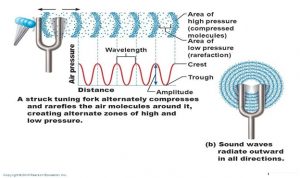
Source: (Pierson, 2019)
A tuning fork illustrates the oscillations of sound. After being struck, the tuning fork vibrates with a simple pattern that repeats itself over time. (Entokey, 2019) Figure 13.3 shows that the tuning fork, when struck, exerts a force on the air molecules which alternatively exerts a high pressure (compression) and a low pressure (rarefaction) zones. The zones exhibit wave amplitude and wavelength as a function of air pressure and distance. The sound wave is distributed 360 degrees through the air.
Figure 13.4: Tuning fork oscillations over time (Entokey, 2019)
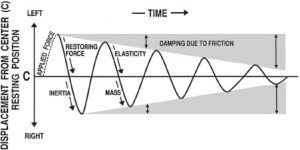
Source: (Entokey, 2019)
Figure 13.4 diagrams a tuning fork’s oscillations over time. Sounds that are associated with simple harmonic motion are called pure-tones. Vertical displacement amount of the tuning fork prong displacement around its resting position. Distance from left to right represents the progression of time. One complete round-trip or replication of an oscillating motion is called a cycle. The number of cycles occurring in one second is the frequency. The duration of one cycle is called it’s period. This form of motion occurs when a force is applied to an object having properties of elasticity and inertia. Simple harmonic motion (SHM) shows the same course of oscillations as in Figure 13.4 because they repeat themselves at the same rate until friction causes dampening of the waveform. (Entokey, 2019) and (Gelfand S. A., 2009)
Other Parameters of Sound waves
Probably the most useful SHM waveform is the sinusoidal wave or sign wave.[3]
The number of times a waveform repeats itself in one second is known as the frequency or cycles per second (CPS). (Gelfand S. A., 2009)Two useful relationships are: f = 1/ t or t = 1/f; where f is the frequency in cps and t is the period in seconds. Amplitude denotes the magnitude of the wave. The peak-to-peak amplitude is the total vertical distance between negative and positive peaks. The peak amplitude is the distance from the baseline to one peak. The magnitude of sound at any instant is the instantaneous amplitude. Wavelength (λ) is the distance traveled between one peak and the next. (Gelfand, 2004)
The wavelength formula is: λ = c / f, where c is the speed of sound in air (344 m/s. f is the frequency of sound in Hz. Similarly, frequency is inversely proportional to wavelength or f = c / λ. (Gelfand S. A., 2009) Another interesting sound parameter is Pitch. Pitch is the quality of sound and especially a musical tone, governed by the rate of vibrations producing it. It is the degree of highness or lowness of sound. (Merriam-Webster, 2019)
Complex waves
When two or more pure-tone waves are combined, the result is a complex wave. (Gelfand, 2004) They may contain any number of frequencies. Complex periodic waves have waveforms that repeat themselves. If they don’t, they are aperiodic. Combining waves may reinforce themselves or cancel themselves whether they are in phase or out. The lowest frequency component of a complex periodic wave (like a combination of sign waves) is called its fundamental frequency. (Gelfand, 2004)
Harmonics are a whole number or integral multiples of the fundamental frequency. Waveforms show how amplitude changes with time. (Gelfand, 2004) Fourier’s Theorem shows that complex sound waves can be mathematically dissected into pure tones.
Of more interest to UAS designers are aperiodic sounds made up of components that are not harmonically related and do not repeat themselves over time. The extreme cases of aperiodic sounds are transients and random noise. A transient is an abrupt sound that is very brief in duration. Random noise has a completely random waveform, so it contains all possible frequencies in the same average amplitude over the long run. Random noise is also called white noise, like white light, because all possible frequencies are represented.
Standing Waves and Resonance
We have arrived at the crux of the acoustic countermeasures discussion, the natural or resonating frequency, which is defined as:
“The frequency(ies) at which a body or medium vibrates most readily is called its natural or resonant frequency(ies).” (Gelfand S. A., 2009) Differences in resonance frequency ranges enable different devices to act as filters by transmitting energy more readily for certain high, low, or band-pass frequencies. UAS with multiple rotors circulates the rotors to gain lift and/or hold steady / or descend in altitude. Four, six, eight – rotor UAS maintains control via internal SCADA systems and sends critical information through a MEMS component located at the bottom of rotors. Rotor frequencies are coordinated, monitored, and position-controlled through the MEMS and in-board computers. Even though the rotor(s) motions are spinning circularly, the sound wave generation is not curvilinear or aperiodic but transferred up through the Y-axis and back again to its base as it ascends in altitude. There is a tendency to maintain equilibrium in terms of the position of the UAS.
The author contends that the UAS rotor systems act like vibrating strings, and this approach can approximate resonance frequency information. An example of a vibrating spring is when you “pluck” a guitar. The waves initiated move outward toward the two tied ends of the string. The waves are then reflected, and they propagate in opposite directions. The result is a set of waves moving toward each other, resulting in a perturbation sustained by continuing reflections from the two ends. The superimposed waves interact and propagate and appear as a pattern that is standing still. Peaks (maximum displacement) and no displacement (baseline crossings occur at fixed points along the string. Places along the spring where zero displacement in the standing wave pattern are called nodes. (Gelfand, 2004) Locations where the maximum displacement occurs are called antinodes.
Figure 13.5: Standing wave (Administrator, 2015)

Source: (Administrator, 2015)
“The fundamental frequency is defined as the lowest frequency of a periodic waveform. It is generally denoted as ‘f .’The lowest resonating frequency of a vibrating object is called the fundamental frequency.” (Administrator, 2015)
“Harmonic is a frequency, which is an integer multiple of the fundamental frequency. The forced resonance vibrations of an object are caused to produce standing waves. At the natural frequency, it forms a standing wave pattern. These patterns are created at specific frequencies; they are called Harmonic Frequencies of Harmonics.” (Administrator, 2015)
“The sound produced by a waveform at its harmonic frequency is very clear, and at other frequencies, we get noise and cannot hear the clear sound of waves. Harmonics may occur in any shaped waveforms, but mostly they occur in sine waves only. Non – sinusoidal waveforms, like triangular and sawtooth waveforms, are constructed by adding together the harmonic frequencies. The word harmonic is generally used to describe the distortions caused by different un- desirable frequencies called noise, of a sine wave.” (Administrator, 2015)
“Node and antinodes occur in a waveform. So, the waves have a harmonic frequency in them. The fundamental frequency is the smallest frequency in a harmonic. Hence there is only a single antinode occurs between them. This antinode is in the middle of the two nodes. So, from this, we can say that the guitar string produces the longest wavelength and the lowest frequency.” (Administrator, 2015)
“The lowest frequency produced by any instrument is called the fundamental frequency. This is also known as the first harmonic of the wave. In words of the fundamental frequency, harmonics are the integer multiples of the fundamental frequency.” (Ex: f,2f,3f,4f, etc.… are harmonics.) (Administrator, 2015)
“Because of multiple integers of the fundamental frequency, we will have n number of harmonics like 1st harmonic, 2nd harmonic,3rd harmonic, and so forth.” (Administrator, 2015). “The fundamental frequency is also called as First harmonic. In the first harmonic, we have two nodes and one antinode. The numbers of antinodes are equal to the integer multiples of specific harmonics. i.e., for 1st harmonic we have 1 antinode, for 2nd harmonic, we have 2 antinodes, etc.” (Administrator, 2015)
The formula for the string’s resonant frequency Fo is:
Fo = 1 / 2L x √T /M Equation 13.5
Fo is resonance frequency in Hz, T is Tension, M is Mass, L = λ /2 and f = c / λ, and c = speed of sound. L = length of the string. (Gelfand, 2004) The string’s lowest resonant frequency is f = c / 2 L, but Eq. 13.5 considers that the speed of sound is different for a vibrating string than air.
In terms of UAS. Countermeasures, why are Acoustics so important?
They are important because:
- Offensive systems use ultrasonic frequency resonance
- It cannot be heard by humans when used to intercept a drone
- Passive systems are difficult, if not impossible, to detect
- Able to identify and track drones based on acoustic and visual signature
- Acoustic detection systems are limited in range ~ 350 ft. to 500+ ft. due to environmental variables. Still, commercial companies like LRAD Corporation have developed long-range acoustic devices that can detect a UAS up to a mile away at altitude. (LRAD, 2019)
- It can be a cost-effective way to defend a small area –especially against Swarm Attacks. (Nichols R. K., 2019) (Nichols & al., Counter Unmanned Aircraft Systems Technologies, and Operations, 2020)
What are the Acoustic Detection Issues?
Detection relies on the uniqueness of the UAS and hearing capabilities at low frequencies:
- Detects drones by recognizing the unique sounds produced by their motors
- Rely on a library of sounds produced by known drones, then matched to sounds detected in the operating environment.
- The human ear is a problem for the designer.
- It is most sensitive to frequencies around 3500 Hz and can hear sound down to a practical threshold of 10 dB
- For a given sound pressure level, attenuation of sound with distance in the air and insulating material varies as the square of the sound frequency.
- Low-frequency sound presents a greater problem for UAS stealth design.
- The greater noise problem is posed by smaller UAS using piston engines.
- Sound comes from their internal combustion and exhaust systems.
- Sound emission can be reduced with sound-absorptive materials, silencers, and mufflers and by directing the intake and exhaust manifolds upward.
- The level of sound detected depends on the level of background noise for sound contrast.
- Limited range to 500 feet (experimental and research – not commercial or military)
- Noisy backgrounds (airports, city downtown) limit detection & interdiction
- Drone tuning (changing the stock propellers) limits detection / Interdiction. (Nichols & al., Counter Unmanned Aircraft Systems Technologies, and Operations, 2020) (Nichols R. K., 2019)
Can UAS acoustic signatures be reduced?
Yes because:
- Aircraft noise may be the first warning of its presence
- However, it may not immediately be directionally/locatable for detection
- UAS noise emanates predominantly from vortices, tips of wings, rotors, or propellers
- Lowering wingspan or blade span enhances acoustical stealth
- Conventional propulsion systems are a concern because of the noise of combustion
- Electric motors develop virtually no noise
- Reducing the mass and aerodynamic drag of the UAS reduces noise generation (Nichols & al., Counter Unmanned Aircraft Systems Technologies, and Operations, 2020)(Nichols R. K., 2019)
Is Acoustic Quieting possible?
“Yes, under certain conditions:
- Disguise sounds from sensors to eliminate their noise and passive echoes
- The Navy used “Acoustic superiority” to mask the detection of US submarines
- Acoustic technology is “passive,” meaning it is engineered to receive pings and “listen” without sending out a signal which might reveal its location to an enemy.
- Increased use of lower frequency active sonar and non-acoustic methods of detecting.”(Nichols R. K., 2019) (Austin, 2010) (Nichols & al., Counter Unmanned Aircraft Systems Technologies, and Operations, 2020)
What is an Acoustical attack on the UAS’s Gyroscope?
There are two possibilities: compromising the sound source or drone on drone attack:
Compromising the Sound Source
- UAM with speakers (consider police and military operations or search-and-rescue operations)(Usenix. org, 2019)
- Counter the source of the sound from the speaker with a different frequency sound
- A jamming attack aims to generate ultrasonic noises and cause continuous membrane vibration on the sensor, making the measurements impossible.
- The level of noise causes performance degradation.
Drone on Drone Attack
- Taking a picture of a moving object from UAM,
- An adversary drone equipped with a speaker could steer itself toward a victim drone and generate a sound with the resonant frequency of the victim’s gyroscope to drag it down(Usenix.org, 2019) [4]
How has the Long-Range Acoustic Device (LRAD) been used as a sonic weapon?
It has been used primarily for denying GPS navigation: [5]
GPS Denied Navigation
- GPS navigation relies on measuring the distance or delay to several known transmitters to triangulate the mobile receiver’s position
- The GPS-denied environment presents navigation challenges for UAVs and UAMs.
- These areas include urban canyons, forest canopy, etc.
- Strike Resonance frequency – which disrupts balance (vehicles tilt, orientation & rotation) (LRAD, 2019)
LRAD
LRAD stands for Long-Range Acoustic Devices. They have been used to address protestors, knock pirates off their attacking boats, disable soldiers in the field, and knock out UAS in the air. (English, 2022) The LRAD is a device that can put out a highly directional “beam” of incredibly loud sound, up to 160 decibels (dB). (English, 2022)
To understand how loud 160dB is, it’s important to understand that volume, or “sound pressure level” (SPL), is not a linear measure: an increase of 10dB corresponds to a tenfold increase in SPL. A 20dB increase would be a 100-fold increase in SPL. As a rough reference, standing directly behind a jet engine as it takes off is between 130 and 140dB, and nearby gunshot rates are approximately 150db. Anything over 140dB will cause pain for most people, but even sounds over 120dB can cause permanent hearing damage from even short periods of exposure. (English, 2022) See https://youtu.be/QSMyY3_dmrM for a demonstration of LRAD G20 by police at a Pittsburg protest. (English, 2022)
Figure 13.6 LRAD

Source: (LRAD , 2022)
NATO Autonomous Mine Sweepers (ATM)
Research is ongoing to detect underwater mines and submarines. Underwater mines don’t necessarily need to detonate on contact with a ship. Many explode when they sense the acoustic sounds that ships give off when passing through a waterway or by detecting the magnetic signatures of the metals used to construct ships. (NATP OTAN, 2014)
Figure 13.7 NATO OTAM ATM
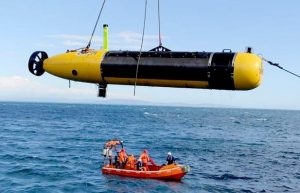
Source: (NATP OTAN, 2014)
Figure 13.7 shows NATO’s MANEX experiment. Mines are an inevitable consequence of an unstable world. The legitimate use of mines includes protecting sovereign waters from covert operations that might be illegal in international law. In times of war, supply routes may be mined to cripple an enemy’s war efforts. The above method of deploying mine is crude and potentially still risky to the human operators. It has been used as a ship defense.
Figure 13.8 LRAD Ship Defense on USS ESSEX

Source: (USS Essex conducts a Straits Transit exercise in the Pacific Ocean by #PACOM, 2015)
MEMS
What is a MEMS, and how does it relate to the UAS gyroscope?
As shown in Figure 13.9 MEMS Gyroscope,
- MEMS (Micro-Electro-Mechanical-Systems) gyroscopes are located in the rotor systems of most drones
- Visualization of a MEMS gyroscope is a single proof mass suspended above a substrate
- The proof mass is free to oscillate in two perpendicular directions, the drive, and sense
- (Said Emre Alper, December 2008)
Figure 13.9: MEMS Gyroscope

Source: (Said Emre Alper, December 2008)
A very interesting presentation on MEMS is available at (Said Emre Alper, December 2008).
Resonance Effects on MEMS – we have arrived at the NUB of this section
Achieving resonance frequencies can have a significant effect on countering hostile UAS:
- MEMS Gyroscope can be degraded using harsh acoustic noise (Yunmonk Son, 2015)
- MEMS Gyroscope has a resonant frequency that is related to the physical characteristics of its structure (Usenix.org, 2019)
- MEMS gyroscopes have resonant frequencies much higher than can be heard (audible and ultrasonic ranges)
- Unexpected resonance output caused by an attack will cause the rotor system to malfunction (Yunmonk Son, 2015)
- Rotors will spin at differing speeds causing the drone to become unstable and crash(Yunmonk Son, 2015)
What is Resonance Tuning?
- “In the operation of MEMS gyroscopes, the bending changes the capacitance between the sensing mass and the sensing electrode, and this capacitance change is sensed as the gyroscope
‘s output.
- Using an additional feedback capacitor connected to the sensing electrode, the resonant frequency and the magnitude of the resonance effect can be tuned.
- A malicious attacker can induce resonance if resonant frequencies exist in gyroscopes”(Nichols R. K., 2019)
What is the “so what” for Acoustics?
Here are the author’s thoughts:
- “Passive detection is much cheaper and cost-effective to operate vs. a complex radar system for a single installation (limited by detection range ~350ft- 1000ft)
- MEMS gyroscopes contained in rotor systems are very susceptible to malfunction when struck with rough noise that resonates inside the MEMS
- Offensive acoustic systems are currently mounted, could become man-portable
- National ELINT assets do not detect offensive systems
- not looking for acoustic energy signatures; the enemy can remain hidden from detection when using acoustics.”(Nichols R. K., 2019)
Are there Countermeasures for Acoustic attacks on gyroscope?
“Yes, some but not totally effective:
- Physical Isolation – provide physical Isolation from the sound noise
- Surrounding the gyroscope with foam would also be a simple and inexpensive countermeasure
- Differential Comparator
- Using an additional gyroscope with a special structure that responds only to the resonant frequency, the application systems can cancel out the resonant output from the main gyroscope.
- Detect and cancel out analog sensor input spoofing against CIEDs.”(Nichols R. K., 2019)
South Korean Experiment
In the author’s judgment, a brilliant and innovative paper by Yunmonk son et al. from the Korean advanced institute of science and technology (KAIST) is the seminal paper on taking down drones using sound noise on gyroscope sensors! (Yunmonk Son, 2015)
(Yunmonk Son, 2015) describes the relationship between Sound Pressure Level (SPL) and Sound Amplitude and derives the attack distance, d as (in dB):
SPL = SPLref + 20 log (A / Aref ) Equation 13.6
Where SPL = sound pressure level, SPLref is the reference, A and Aref are the amplitudes of the source and reference point. Using real-world experiments (Yunmonk Son, 2015) found that:
SPL = SPLref – 20 log (d / dref ) Equation 13.7
Where d, dref are the attack scenario distances.
KAIST under (Yunmonk Son, 2015) primary conclusions are:
- 1) “Many sensing and actuation systems trust their measurements and actuate according to them. Unfortunately, this can lead to security vulnerabilities that cause critically unintended actuation.
- 2) The sound channel can be used as a side channel for MEMS gyroscopes from a security point of view.
- 3) Fifteen kinds of MEMS gyroscopes were tested, and seven were found vulnerable to disruption using intentional noise.
- 4) The output of the vulnerable MEMS gyroscopes was found using a consumer-grade speaker to fluctuate up to dozens of times due to the sound noise.
- 5) The authors found that an attacker with only 30% of the amplitude of the maximum sound noise could achieve the same result (disruption) at the same distance.
- 6) At 140 decibels, it would be possible to affect a vulnerable drone up from around 40 meters away,
- 7) Some drone gyroscopes have resonant frequencies in both the audible and ultrasonic frequency ranges, making them vulnerable to interference from intentional sound noise.
- 8) Authors found that accelerometers integrated with MEMS gyroscopes were also affected by high-power sound noise at certain frequencies.”(Yunmonk Son, 2015)[6]
NOISE
Loud and abrupt sound as a countermeasure also brings the problem of exposure and loss. Chapter 17 of (Gelfand S. A., 2009) discusses the effects of noise and hearing conservation. Chapter 20 of (Gelfand S. A., 2009) discusses occupational standards. Safety is an important topic but outside the scope of this writing.
UAS. Collaboration – SWARM
Recall that the authors previously defined in Chapter 3 of (Nichols & Mumm, Unmanned Aircraft Systems in the Cyber Domain, 2nd Edition., 2019) a UAS SWARM as a uniform mass of undifferentiated individuals w/o Chief at automation level 4 or 5. SWARMs exhibit the following advantages:
- Efficient based on numbers, emergent large group behaviors, and reactions
- Not controllable or automated, decentralized intelligence
- Think shoal of fish w/ evolving local rules; highly resistant form
- Not changing based on survivability of members, no hierarchy
SWARM Countermeasures include disruption, i.e., changing the Strategic Global View of SWARM (its only real vulnerability), complete Defender collaboration with multiple kinetic and non-kinetic countermeasures, and use of Acoustic Countermeasures for identification as friend or foe (IFF) based on a library of manufacture detection signatures and complete, abrupt rotor disablement by attacking the SWARM units with resonant, loud (100-140 dB) sound noise aimed directly at the MEMS gyroscopes or close by on the unit. [Think of glass breaking at resonance frequency or a submarine under depth charge attack. The former breaks by super-excited molecules in the glass and literally shakes apart. The latter is destroyed by the violent shaking of the submarine so that its parts break, and flooding ensues. It is unnecessary to hit the submarine directly because explosions in water, hence sound waves and explosive forces, carry very far and effectively to the target.]
Remember the Problem the Wildcat team has addressed in every book of our series.
Which is:
The Risk of success of Terrorist Attacks on US Air and Naval Defense Systems (ADS/NDS) via sUAS / UAS is higher and improving because of commercial capabilities and accessibility. Advanced small drones capable of carrying sophisticated imaging equipment, significant (potentially lethal) payloads, and performing extensive Intelligence, Surveillance, and Reconnaissance (ISR) missions are readily available to the civilian market. They pose a significant threat to civilian and military UAS operations and safety in the NAS and operations on the sea. Hostile UAS presents the highest threat to ADS / NDS. Swarms.
A Problem Solution Not The ONLY Problem Solution:
The author’s research suggests that UAS. Swarms can be both identified (IFF) and destabilized/mitigated/eliminated/countered in the air by applying harsh acoustic countermeasures at resonance frequencies.UAS (in any formation – especially Swarms) present detectable acoustic signatures that can be collected in IFF sound libraries. They are unique to the make, model, and origin manufacturers like fingerprints or DNA. Once identified as hostile, UAS (Swarm units) may be destabilized by harsh – explosive amplitude acoustic countermeasures to the MEMS or rotor base of the UAS, causing destabilization of the UAS and grounding. Emergency and waypoint recovery functions do not work under this approach.
Switching to A Dangerous Theater of Operations (TO) – Chinese Drones in the Spratly Islands, and Chinese Threats to USA forces in the Pacific
The authors now take an abrupt turn to the South China Seas (SCS) and the threatening influence of China. We are certain of cyber weapons in the SCS, especially in the neighborhood of the Spratly’s. We are not certain that acoustic weapons are being used in this TO. However, if PLAN has been watching, the Russians have already employed them against US diplomats. It would be an economic benefit to use them. Also, China (PLAN) has made significant moves to take over the Solomon Islands; they are negotiating deals in Papua, New Guinea and economic assistance to Kiribati, only 1900 miles south of Hawaii. In Pacific terms, Kiribati is America’s next-door neighbor. (Chang, 2022) China continues years of persistent commercial, diplomatic, and military efforts to own the Pacific. They intend to put military bases along with the New Silk Road Strategic Plan for land and sea. Like flies to a spider, money opens the door to future treachery to both the fly and its neighbors.
China uses economic framework agreements to hook its clients and bring in PLAN forces. These framework agreements, when fully implemented, will give China the ability to sever shipping lanes and air links connecting the US with its treaty ally Australia and partner New Zealand. (Nichols & Ryan, Unmanned Vehicle Systems & Operations on Air, Sea & Land, 2020) If Chinese forces should soon move on Taiwan ala the Russian Invasion of Ukraine, they will use ISR assets and special UAS / UUV capabilities developed in the Spratlys. They will use both kinetic and non-kinetic means to accomplish their control of Taiwan. As recently as April 2022, Taiwan has been building up its defenses against Chinese drones. They have already been spotted over Dongsha Island. The Coast Guard Administration (CGA) says the Chinese threat will likely rise as Taiwan-US cooperation strengthens. (Strong, 2022)
Figure 13.10 Location of Dongsha Island and Taiwan

Source: (Dongsha Island – Taiwan, 2022)
Location of the Spratly Islands and Their Strategic Importance
The Spratly Islands are a disputed group of islands, islets, cays, and more than one hundred reefs in the South China Sea. Named after British Whaling captain Richard Spratly in 1843, they represent only 490 acres spread over 164,000 square miles. The archipelago lies off the coasts of the Philippines, Malaysia, and China (Wikipedia, 2022)
Figure 13.11 Spratly Islands

Source: Courtesy of (Wikipedia, 2022) Spratly Island Fact Page; also (Google, 2022)
Figure 13.12 Spratly Islands

Source: Courtesy of (Google, 2022)
Although there are some civilian settlements in the approximate 45 islands, all contain structures occupied by military forces from Malaysia, Taiwan (ROC), China (PRC), the Philippines, and Vietnam. Brunei has claimed an exclusive economic zone around the Louisa Reef (Wikipedia, 2022). Figures 13.8 and Figure 13.9 show the Spratly Islands. Officially they are in the South China Sea at 10 degrees N, 114 degrees E.
Target Drones
The Spratlys may be disputed in theory, but the undeniable winner in any real in this TO would be China. China has made huge investments in defensive infrastructure, military, unmanned aircraft, and boats to solidify its position in the Spratlys. China has one of the largest UAS intelligence operations in the Spratlys and regularly conducts drills. These drills simulate fending off an aerial attack. The drills, which involve three target drones making flyovers of a ship formation at varying heights and directions, are part of the ongoing efforts to improve its real-life combat ability. The drones have been sent out several hundred times during more than thirty drills. (Chinese navy deploys drones in South China Seas missile drills. Diplomacy and Defense article, 2018)
China announced in July 2021 that it conducted secret naval drills in the Taiwan Strait even as the self-governing island reasserts its sovereignty and wants to safeguard its free and democratic system. (Ghosh, 2021) According to South China Morning Post, Beijing has recently declassified a report on the development of drone submarines, a project it had started in 2010. While many countries are developing or have already developed unmanned underwater vehicles (UUVs), the timing of China’s announcement is interesting. China has developed underwater drones capable of identifying, tracking, and attacking an enemy submarine without human interference. Sound plays a big part in the location of the target. (Ghosh, 2021)
Shark Swarm and Wanshan Marine Test Field
China has tested an army of tiny drone ships that can “shark swarm” enemies during sea battles. It has a fleet of fifty-six unmanned craft sent out on maneuvers off the Wanshan Archipelago in the South China Sea. The Chinese firm Oceanalpha confirmed that the drones were designed to overwhelm enemies in sea battles. A mothership controls the armed swarm.[7] Oceanalpha confirmed that the Wanshan Marine Test Field was constructed sole purpose of conducting drone craft drills (Barnes, 2018)
Fast Drone Ship
In December of 2017, HiSIBI, a Chinese nautical firm, announced the development of the world’s fastest drone ship, which can travel at 50 knots (58 mph).[8] The new speed drone is being tested in the Wanshan Marine Test field. The test field is still under construction and is believed to be the world’s largest test field, covering over 297.9 square miles. Military observers have indicated that the test site for unmanned vessels is part of China’s overall plans to develop autonomous systems for civilian and military applications. The new test site dovetails with China’s push to use technology to safeguard China’s maritime interests. (China starts work on world’s biggest test site for drone ships near the South China Sea, 2018)
Long-Range UUV
Tianjin University researchers completed a sea test of the Haiyan autonomous Unmanned Underwater Vehicle (UUV). It can endure for 30 days and has a 621.37miles range (Lin, 2014). Just as the US Navy is conducting UUV research for facing off against China’s growing Anti-Access Area Denial capabilities, the Chinese are building up these capabilities. UUVs cover a larger area, can operate more efficiently, and use multiple sensors to monitor water temperature, conductivity, optical backscatter, and acoustics. Multiple sensor types increase the probability of finding the prey in the battle mode for detecting a stealthy submarine. Unlike fixed underwater sonar stations, UUVs can be rapidly deployed via ships or airdrops to newly uncovered areas (such as Taiwan Straits or the South China Sea), where mobility complicates enemy efforts to disrupt and destroy them. (Lin, 2014)
The Haiyan UUV is part of the deployed assets for an Underwater Great Wall, a network of sensors on the seabed, coupled with long endurance UUVs to identify and destroy enemy submarines and mines. The sister fish-like Qianlong autonomous underwater vehicle (AUV) can dive to 14,800 feet, indicating Chinese interests in deep-sea robotic ships. These UUVs can also attack targets anywhere in the Indian Ocean and collect enemy submarine acoustics and oceanographic conditions for improving stealth and anti-stealth measures. (Katoch, 2018)
Crisis Watch
The US and China are in a power struggle in the South China Sea centered around the US countering Chinese military operations in the Spratlys. Prior Defense Secretary General Mattis addressed some of the disputed issues at the Shangri-La Dialogue Asia security summit in Singapore on June 2, 2018:
US Sec Defense Mattis outlined the US “Free and Open Indo-Pacific Strategy,” consisting of expanded maritime security support for US partners, helping regional navies become more interoperable with the US Navy, strengthening governance through defense engagements and private sector-led development. Mattis said the US wants to work with regional multilateral institutions, particularly ASEAN; new US national security and defense strategies emphasize Indo-Pacific; said cooperation with China is “welcome wherever possible .”Mattis criticized China’s militarization of features in the disputed Spratly archipelago. Also, addressing Shangri-La Dialogue, China, for the first time, publicly acknowledged that it was basing weapons and military personnel on disputed features it controls in Paracel and Spratly Islands, which it said are Chinese territory. Chinese military representative said Mattis’s comments were “irresponsible” and that the US was the one militarizing, citing US air and naval passages within twelve nautical miles of Chinese-controlled territory. US June 5 flew two B-52 bombers over disputed Scarborough Shoal near the Philippines; China sent ships and aircraft and said the US was “stirring up trouble .”Reuters June 3 reported that the US is considering stepping up its naval operations near disputed features. The US held an annual Malabar naval exercise with India and Japan from 7-16 June off the coast of Guam and in the Philippine Sea. Biennial U.S. Rim of the Pacific (RIMPAC) naval exercises began June 27 without China after US late May rescinded China’s invitation to participate. On June 8, ImageSat International reported that China had redeployed surface-to-air missile systems to Woody (Yongxing) Island in Paracels. PLA navy, on June 15, carried out missile drills in the South China Sea (SCS). The UK and French defense ministers on June 3 said they would send more naval ships through SCS to assert the right to freedom of navigation. Meeting with Sec Defense Mattis in Beijing on June 27, President Xi Jinping reasserted that China would not give up any of its territorial claims in SCS; also called for deepening military-to-military ties. (Crisis Watch, 2018)
The Pentagon claims evidence that the Chinese have deployed anti-ship missiles, surface-to-air missiles (SAM) systems, and electronic jammers to the Spratly Islands. The Chinese have landed bomber aircraft at Woody Island. (Huang, 2018) This is along with the new drone systems and intelligence UAS assets discussed supra.
Red Drones over Disputed Seas
One of the best reports on how the Chinese military uses unmanned drones for power projection and surveillance in the contested South and East China Seas was written by (McCaslin, 2017). China is currently undergoing a “drone” driven by heavy investment in the Chinese drone industry and by illegal acquisition of foreign drone technology (Katoch, 2018).
US DOD predicts China will produce tens of thousands of drones by 2023 (DoD Report, 2015). Drone sightings and proper identification are important because of the lack of international rules governing the treatment of drones, including in areas where sovereignty is contested (Lehman, 2017).
The report documents four drones known to be used by PLAN: The S-100, ASN-209, BZK-005, and the GJ-1. All but the S-100 are Chinese-produced. Scheibel makes the S-100 in Austria. The drones discussed fill a variety of roles, from surveillance (S-100) to military/weaponized (GJ-1, aka Wing Loong I model) (Lehman, 2017)
One limiting factor facing Chinese power projection is the inability of their current inventory to runway launch from aboard the Chinese Navy’s sole aircraft carrier. This limits the BZK-005 (primary mission surveillance) from being launched from land (McCaslin, 2017). The S-100 uses vertical take-off and landing (VTOL) system and does not have this problem. Additionally, drones can be launched from Chinese-controlled artificial islands in contested areas [i.e., the Spratly Group.] (Lehman, 2017)
The author contends that the BKZ-005 is suspected of being outfitted with cyber and sonic weapons to harass the US Naval forces in the Spratly AO, causing chaos with the commercial and potentially US navy GPS systems.
Figure 13.13 S-100 Chinese Drone
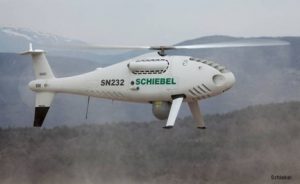
Source: (Wikipedia, 2018)
The S-100 has an 18,000-foot ceiling, weighs 75 pounds armed with Thales Lightweight Multi-role Missiles (LMM), with a range of 60 to 125 miles, and can be operational for 10 hours. They are generally launched from a PLAN Type 054 /054A frigate. (McCaslin, 2017)
China uses the S-100 for intelligence, surveillance, and reconnaissance (ISR). They are equipped with Synthetic Aperture Radar (SAR), Maritime Radar, Signal Intelligence (SIGINT), and Communications Intelligence (COMINT) payloads. See Figures 13.14 for S-100 views and ranges.
Figure 13.14 S-100 Drone Trajectories in the Spratly Islands
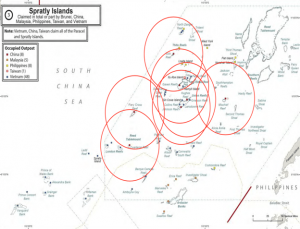
Source: (McCaslin, 2017)
Figure 13.15 BZK -005 Chinese Drone
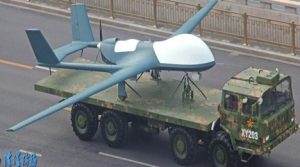
Source: (Wikipedia BZK-005, 2018) Chinese UAS
BZK -005
The BZK-005 is also a MAME drone for specialized surveillance missions. It has an operational ceiling of 26,247 feet, with a maximum range of 1491 miles and an endurance of 40 hours. The range is limited by ground-based runways, i.e., the Spratly Islands group. (McCaslin, 2017)
It is equipped with electro-optical, infrared, SAR, SIGINT, and satellite communications systems, allowing real-time data transmission capability. See Figure 13.15 for the BZK-005 view.
The BZK-005 range permits surveillance over the entire South China Seas if launched from Chinese – controlled islands (artificial and natural): Woody Island, Subi Reef, Mischief Reef, and Fiery Cross Reef. (McCaslin, 2017)
Figure 13.16 Chinese UAS. Chinese Intelligence Assets Deployment in Spratlys

Source: (Nichols & & Carter, RSCAD Presentation of Research to KSUP Faculty on SCS Drone Activity, (4 May 2018))
Professor Nichols and Carter have been tracking Chinese intelligence assets, UAS, UUV, underwater bases, cyber, spoofing, and sonic incidents involving American capital ships and submarines in the South China Seas (SCS) since 2017. They have compiled quite a storehouse of information and made multiple research presentations on the subject. Their present concern is the threat to Taiwan. The team uses DRONESEC tracking and a professional version of http://www.globalincidentmap.com/ to support its work.
DRONESEC Report April 2022
We asked DRONESEC out of Singapore to use their tracking programs to update malicious and suspicious cyber or acoustic incidents involving UASs or UUVs or malicious incursions in SCS and near Taiwan. Arison Neo, the lead threat analyst, reported: ” I believe there are manned ships and aircraft incursions happening more rampantly in the SCS, but the Notify platform only tracks and collates drone incidents., I added some that were of the UUV category. Here are the results.” (Neo, Suspicious Drone Incidents in SCS involving Cyber or Acoustic , 2022) See Figure 13.17.
Figure 13.17 Malicious Drone Activities in SCS near Taiwan
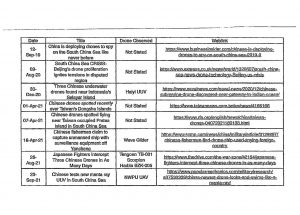
Source: (Neo, Aerial and UUV suspicious drone incidents in the SCS, 2019-2022)
Our last topic is the malicious acoustics affecting the brain. Our S.M.E., Robert McCreight, gives us a lesson on Havana Syndrome.
Acoustic Dynamics: Havana Syndrome and Neurological Vulnerability (McCreight, Acoustic Dynamics: Havana Syndrome and Neurological Vulnerability, 2022)
In 2022, we must reckon with a strategic threat that is invisible, insidious and defies facile detection. It operates covertly and often inflicts permanent cognitive degradation effects on anyone unlucky enough to dwell within the scope and scale of its non-kinetic yet ethereal and disruptive beam. Blending nano-pulsed RF signals and various acoustic wave technologies that have a measurably negative impact on the human brain can cause epigenetic neuro-modulation, including cognitive harm. It is a distinct domain of warfare rooted in our neurological vulnerabilities. In popular parlance, its victims suffer from something we refer to as Havana Syndrome. While a degree of mystery surrounds its core elements, its origins, sponsors, or offending technologies verify the sheer authenticity of its harmful effects and damage to many hundreds of victims. It is a defiant witness to an existing and enduring threat we cannot afford to ignore. Operating now for more than six years, we still lack an effective solution.
Havana Syndrome symbolizes a unique form of hostility based partially on acoustic technologies that enter our brain through our vestibular and cochlear systems. Havana Syndrome should be viewed as an opening salvo in the long-term threat we understand dimly as ‘cognitive warfare.’ Cognitive warfare exists within the human/warfighter context. Arguably it is the sixth arguable dimension of future conflict and must be understood as such. Apart from land, sea, air, space, and cyber is a brain-based battlefield nested in human systems, which is well recognized but only dimly appreciated. In cognitive warfare, the human mind is the target. Cognitive warfare aims to change what people think, what they perceive, what they remember, and how they think or act—indeed, it externally manipulates brain functions and corrupts the Central Nervous System [CNS]. While its victims thus far have been overwhelmingly American, there were also Canadian victims, and the threat this poses to America’s allies cannot be dismissed. Operating silently amongst us and engaging selected targets within the alliance, cognitive warfare—just as AI and cyber threats are seen—becomes a doorstep towards redefining what a true ‘act of war’ really is. As recently noted in the NATO Review, “Waged successfully,[cognitive warfare] shapes and influences individual and group beliefs and behaviors to favor an aggressor’s tactical or strategic objectives. In its extreme form, it has the potential to fracture and fragment an entire society so that it no longer has the collective will to resist an adversary’s intentions. An opponent could conceivably subdue a society without outright force or coercion.” (Kathy Cao, 2021)
Remembering Sun Tzu’s dictum that the pinnacle of skill is to “.subdue the enemy without firing a shot, “…we find cognitive warfare amply demonstrates the power of that observation. Fostering social upheaval and chaos through cognitive warfare effectively reflects the confidence, confusion, and controversy that the public invests in media outlets and social media. Sordid experiences involving propaganda, disinformation, and psychological warfare exerted degrees of measurable societal disruption, planting public unrest among restive groups and classes, undermining the legitimacy of government, subverting lawful authority via staged civil disturbances, or enflaming separatist movements. (McCreight, Cognitive Warfare 2021: Latent AllianceThreats in Neurostrike and Havana Syndrome, 2021)
Acoustics and Havana Syndrome Illustrate our Collective Neurological Vulnerability
When CIA. Director William Burns traveled to India in September 2021; a team member reported symptoms consistent with Havana Syndrome and received medical attention. A month earlier, Vice President Kamala Harris temporarily delayed her arrival in Vietnam after the State Department made her office aware of a “possible anomalous health incident” in the US Embassy in Hanoi. The description of the incidents there as “acoustic” indicates that the affected diplomats heard strange sounds. Then in July 2021, the State Department and the Austrian government said they were investigating possible cases in Vienna that had emerged in previous months. In addition, other cases involved two senior national security officials adversely affected during the Trump administration. They included Olivia Troye and Miles Taylor, who CBSNEWS that they too had experienced symptoms consistent with Havana Syndrome. (Pelley, 2022) Ms. Troye served as homeland security and counterterrorism adviser to Vice President Mike Pence. Then in February 2022, Mr. Burns, Director of the CIA, found that some incidents of Havana Syndrome are most likely caused by directed energy or acoustic devices and can’t be explained by other factors. (Strobel, 2022)
Experts studying the suspected technologies behind Havana Syndrome have concluded that “pulsed electromagnetic energy, particularly in the radiofrequency range, plausibly explains the core characteristics.” However, they concede that such a theory is riddled with “information gaps.” Such nefarious devices exist with capabilities that could generate the required wave beam stimulus. Some said acoustic signals, easily concealable and requiring moderate power requirements, might be responsible. For example, some experts claim that “using nonstandard antennas and techniques, the signals could be propagated with low loss through the air for tens to hundreds of meters, and with some loss, through most building materials.” With the possible exception of ultrasound devices, the report rules out the plausibility of all other proposed causes. The authors point out that their report does not provide evidence for using any such device, nor does it address the issue of who may be behind any hypothetical attack. (DNI, 2022)
The State Department originally said that in 2019 the adversely affected Embassy Havana employees developed what became known as “Havana Syndrome” – headaches, dizziness, nausea, and other symptoms that arose when they heard penetrating high-pitched sounds. According to a study by the University of Pennsylvania, MRI scans from 23 men, and 17 women showed changes in brain structure and functional connectivity between different organ parts compared with 48 other adults. The difference in the brains between the two groups “is pretty jaw-dropping at the moment,” lead researcher Dr. Ragini Verma, a professor of radiology at Penn, told Reuters. “Most of these patients had a particular type of symptoms, and a clinical abnormality is reflected in an imaging anomaly” (McCreight, Cognitive Warfare 2021: Latent Alliance Threats in Neurostrike and Havana Syndrome, n.d.)
NIH FBI saw victims of Havana Syndrome. The University of Miami and University of Pennsylvania medical and neuroscience experts. Then in December 2020, a report issued by the National Academy of Sciences [NAS] said the victims were exhibiting “… a constellation of acute clinical signs and symptoms with directional and location-specific features that were distinctive….unlike any disorder in the neurological or general medical literature”. (NAP, 2022)
Independently, numerous medical studies and research reports affirm the central NAS theory behind what the Academy and its experts say triggered Havana Syndrome. One such example illustrates the core issue.
“Pulsed microwaves may injure brain tissue by transduction of microwave energy into damaging acoustic phonons in brain water. We have shown that low-intensity explosive blast waves likely initiate phonon excitations in brain tissues. Brain injury, in this instance, occurs at nanoscale subcellular levels as predicted by physical consideration of phonon interactions in brain water content. The phonon mechanism may also explain similarities between primary non-impact blast-induced mild Traumatic Brain Injury (mTBI) and recent clinical and imaging findings of unexplained brain injuries observed in US embassy personnel, possibly due to directed radiofrequency radiation. Certain RF frequencies and power levels can trigger pulsed microwaves and potentially injure brain tissue. Microwaves can also be focused into narrow field-of-view beams to target individuals. Experimental evidence indicates that pulsed microwaves can disrupt brain tissue producing subsequent behavioral and cognitive dysfunction. In addition, pulsed microwaves reportedly may alter blood-brain barrier permeability, disrupt long-term potentiation, and result in DNA strand breaks” (Graham K. Hubler1, 2020)
In 2021 numerous press reports were identified of parallel Havana Syndrome complaints from US diplomats posted to Berlin, Hanoi, Borgata, Managua, Vienna, and Guangzhou and at least 19 other posts overseas. This provides additional impetus to find the offending technology and determine how best to protect vulnerable employees. With a net cluster of potential victims among US military, intelligence, and diplomatic ranks, which may exceed 800 in number and rising, serious guardians of America’s security should pay attention to these disturbing developments. (McCreight, Cognitive Warfare 2021: Latent Alliance Threats in Neurostrike and Havana Syndrome, n.d.)
Acoustic Technologies
We know that acoustic technologies can be used to suppress civil disturbances. We offset military threats using a non-kinetic but effective to a width of 120-degree beam out for more than 500 meters. Compared to ultrasonic high-frequency systems, these low-frequency systems have demonstrated their effectiveness in deterring certain categories of maritime threats. This should be seen as universally available to American allies and foes as acoustic systems provide an additional technological tool to enhance the combat power of the United States military. This would include terrestrial, airborne, and underwater acoustic spectrum systems. Rooted in directed energy [DE], we find laser, microwave, and acoustic aspects. Systems such as LRAD illustrate the power and influence of <1000 MGh in delivering piercing sound effects and disruption, which inflicts nausea, headaches, and severe imbalance issues. More must be studied and understood about the net strategic implications of various acoustic technologies devised and developed for possible military use because of their unique non-kinetic properties and the implied battlefield effects of their targeted use as a prelude to, or augmentation of, combat operations. (NCBI, 2005)·
SCREAMERS
We see the future of acoustic weapons in the 1995 film Screamers, a science fiction horror film starring Peter Weller. In the year 2078, the planet Sirius 6B, once a thriving mining hub, has been reduced to a toxic wasteland by a war between the mining company, known as the New Economic Block (NEB), and “The Alliance,” a group of former mining and science personnel. After miners discovered that their ore extraction released toxic gases, they went on strike, and the mining company hired mercenaries as strikebreakers. Five years into the war, Alliance scientists created and deployed Autonomous Mobile Swords (AMS) — artificially intelligent self-replicating machines that hunt down and kill NEB soldiers on their own. They are nicknamed “screamers” because of the high-pitched noise they emit as they attack. Screamers track targets by their heartbeats, so Alliance soldiers wear “tabs” which broadcast a signal canceling out the wearer’s heartbeat and rendering them “invisible” to the machines.
There is nothing to prevent LRAD technology combined with AI from being reduced to cylinder form – payload and deployed by UAS as a SCREAMER against any target of opportunity. (Wikipedia, 2022) [9]
Figure 13.18 AMS – SCREAMER

Source: (autonomous-mobile-sword-miniature-screamers, 2022)
Bibliography
Adamy, D. -0. (2015). EW 104 EW Against a New Generation of Threats. Boston: Artech House.
Adamy, D. (2001). EW 101 A First Course in Electronic Warfare. Boston, MA: Artech House.
Administrator. (2015, June 15). Standing Wave and Fundamental Frequency. Retrieved from Electronics Hub: https://www.electronicshub.org/?s=fundamental+frequency
Austin, R. (2010). “Design for Stealth,” Unmanned Aircraft Systems UAVS Design Development and Deployment. New York: John Wiley and Sons.
autonomous-mobile-sword-miniature-screamers. (2022, April 2). Retrieved from www.liveauctioneers.com/: https://www.liveauctioneers.com/item/6321634_940-autonomous-mobile-sword-miniature-screamers
Barnes, T. (2018, June 7). China Tests an army of tiny drone ships that can ‘shark swarm’ enemies during sea battles. Retrieved from www.independent.co.uk/: https://www.independent.co.uk/news/world/asia/china-drone-ships-unmanned-test-video-military-south-sea-sha
Chang, G. G. (2022, March 31). China Takes over the Solomon Islands – and the Pacific. Retrieved from www.gatestoneinstitute.org/: https://www.gatestoneinstitute.org/18384/china-takes-over-solomon-islands
China has started work on world’s biggest test site for drone ships near the South China Sea. (2018, July 6). Retrieved from www.todayonline.com: https://www.todayonline.com/world/china-starts-work-worlds-biggest-test-site-drone-ships-gateway-south-china-sea.
Chinese navy deploys drones in South China Seas missile drills. Diplomacy and Defense article . (2018, June 6). Retrieved from www.scmp.com/: https://www.scmp.com/news/china/diplomacy-defence/article/2150957/chinese-navy-deploys-drones-south-china-sea-missile/
Corr, a. (2018). Great Powers, Grand Strategies: The New Game in the South China Sea. Naval Institute Press Annapolis.
Crisis Watch. (2018, June). Retrieved from Retrieved from map overlay, https://www.crisisgroup.org/crisiswatch: https://www.crisisgroup.org/crisiswatch
DNI. (2022, Feb 2). statement-from-dni-haines-and-dcia-burns. Retrieved from www.dni.gov/: https://www.dni.gov/index.php/newsroom/press-releases/press-releases-2022/item/2274-statement-from-dni-haines-and-dcia-burns
Dongsha Island – Taiwan. (2022, April 1). Retrieved from https://i2.wp.com/taiwanenglishnews.com/wp-content/uploads/2020/06/Dongsha.jpg?resize=752%2C445&ssl=1: https://i2.wp.com/taiwanenglishnews.com/wp-content/uploads/2020/06/Dongsha.jpg?resize=752%2C445&ssl=1
English, L. (2022, February 20). whats-an-lrad-explaining-the-sonic-weapons-police-use-for-crowd-control-and-communication. Retrieved from theconversation.com/: https://theconversation.com/whats-an-lrad-explaining-the-sonic-weapons-police-use-for-crowd-control-and-communication-177442
Entokey, a. G. (2019, May 16). entokey.com/acoustics-and-sound-measurement/. Retrieved from entokey.com/acoustics-and-sound-measurement/: https://entokey.com/acoustics-and-sound-measurement/
Gelfand. (2004). “Physical Concepts”, Hearing an Introduction to Psychological and Physiological Acoustics, 4th ed. New York City.
Gelfand, S. A. (2009). Essentials of Audiology, 3rd Edition. Stuttgart, DE: Thieme.
Ghosh, A. (2021, July 8). China’s Most Ambitious, Highly Secretive Military Program To Dominate The South China Sea Declassified. Retrieved from eurasiantimes.com/: https://eurasiantimes.com/chinas-most-ambitious-highly-secretive-military-program-to-dominate-the-south-china-sea-declassified/
Google. (2022, April 1). spratly-islands map. Retrieved from www.spratlys.org/: http://www.spratlys.org/maps/1/spratly-islands_95.jpg
Graham K. Hubler1, S. W. (2020, Aug 4). Pulsed Microwave Energy Transduction of Acoustic Phonon Related Brain Injury . Retrieved from https://doi.org: https://doi.org/10.3389/fneur.2020.00753
Huang, P. (2018, May 23). US Disinvites China from International Naval Exercise in Response to South China Sea Aggression . Retrieved from www.theepochtimes.com/: https://www.theepochtimes.com/us-disinvites-china-from-international-naval-exercise-in-response-to-so
Kathy Cao, S. G. (2021, May). Countering Cognitive Warfare—Awareness & Resilience . NATO Review.
Katoch, P. G. (2018, July 4). New Chinese Drones – formidable challenge. Retrieved from spsmai.com/: https://spsmai.com/experts-speak/?id=556&q=new-chinese-drones-formidable-challenge
Kirk, J. (2015, August 5). sounds-can-knock-drones-sky. Retrieved from www.computerworld.com.au/article/581231: https://www.computerworld.com.au/article/581231/sounds-can-knock-drones-sky/
Lehman, C. (2017, august 29). Report: China Increasing Drone Operations in Disputed Seas . Retrieved from freebeacon.com/: http://freebeacon.com/author/charles-lehman
Lin, J. &. (2014, June 4). Not a Shark, But a Robot: Chinese University Tests Long-Range Unmanned Sub. Retrieved from www.popsci.com/: https://www.popsci.com/blog-network/easter-arsenal/not-shark-robot-chinese-university-tests-long-range-unmanne
LRAD . (2022, April 2). Retrieved from i.stack.imgur.com/: https://i.stack.imgur.com/EO1Kg.png
LRAD. (2019, May 189). LRAD 450XL Datasheet. Retrieved from LRADX: http://www.lradx.com/wp-context/uploads/2015/05/LRAD_datasheet_450XL.pdf
McCaslin, I. (2017). Red Drones over Disputed Seas: A Field Guide to Chinese UAVs/ UCAVs Operating in the Disputed East and South China Seas. Retrieved from project2049.net/: http://project2049.net/documents/Red%20Drones%20over%20disputed%20seas_PLA
McCreight, R. (2021, November). Cognitive Warfare 2021: Latent AllianceThreats in Neurostrike and Havana Syndrome . Retrieved from www.vernetztesicherheit.de.: www.vernetztesicherheit.de.
McCreight, R. (2022, April 1). Acoustic Dynamics: Havana Syndrome and Neurological Vulnerability. Carlisle, PA, USA.
McCreight, R. (n.d.). Cognitive Warfare 2021: Latent Alliance Threats in Neurostrike and Havana Syndrome. Retrieved from vernetztesicherheit.de/: https://vernetztesicherheit.de/cognitive-warfare-2021-latent-alliance-threats-in-neurostrike-and-havana-syndrome/
Merriam-Webster. (2019, May 17). Merriam-Webster Online Dictionary.
NAP. (2022). An Assessment of Illness in U.S. Government Employees and Their Families at Overseas Embassies. Retrieved from https://nap.nationalacademies.org/read/25889/chapter/1: https://nap.nationalacademies.org/read/25889/chapter/1
NATP OTAN. (2014, October). naval_mines_mine_countermeasures_hunting_sweeping_destroyer_neutralization_counter_measures. Retrieved from www.bluebird-electric.net/: https://www.bluebird-electric.net/submarines/naval_mines_mine_countermeasures_hunting_sweeping_destroyer_neutralization_counter_measures.htm
NCBI. (2005, Sept 29). Long-Term Effects of Acoustic Trauma on Electrically Evoked Emissions. Retrieved from www.ncbi.nlm.nih.gov/: https://www.ncbi.nlm.nih.gov/pmc/articles/PMC2504617
Neo, A. (2019-2022). Aerial and UUV suspicious drone incidents in the SCS. SCS: DRONESEC.
Neo, A. (2022). Suspicious Drone Incidents in SCS involving Cyber or Acoustic . Singapore: DRONESEC.
Nichols, R. K. (2019, March 14). Hardening US Unmanned Systems Against Enemy Counter Measures. 7th Annual Unmanned Systems Summit. Alexandria, VA, USA: PPTX presentation , self.
Nichols, R. K., & & Carter, C. M. ((4 May 2018)). RSCAD Presentation of Research to KSUP Faculty on SCS Drone Activity. Salina: KSU Aerospace & Technology.
Nichols, R. K., & Mumm, H. C. (2019). Unmanned Aircraft Systems in the Cyber Domain, 2nd Edition. Manhattan, KS: www.newprairiepress.org/ebooks/27.
Nichols, R., & al., e. (2020). Counter Unmanned Aircraft Systems Technologies and Operations. Manhattan, KS: new prairie press #31.
Nichols, R., & Ryan, J. M. (2020). Unmanned Vehicle Systems & Operations on Air, Sea & Land. Manhattan, KS: New Prairie Press #35.
Pelley, S. (2022, February 20). Havana Syndrome: High-level national security officials stricken with unexplained illness on White House grounds. Retrieved from www.cbsnews.com: https://www.cbsnews.com/news/havana-syndrome-white-house-cabinet-60-minutes-2022-02-20/
Pierson. (2019, May 16). tuning-fork-waves-sound. Retrieved from air freshener.club – Pierson Education: https://airfreshener.club/quotes/tuning-fork-waves-sound.html
Said Emre Alper, Y. T. (December 2008). A Compact Angular Rate Sensor System Using a Fully Decoupled Silicon-on-Glass MEMS Gyroscope. JOURNAL OF MICROELECTROMECHANICAL SYSTEMS, VOL. 17, NO. 6.
slideshare.net. (2019, May 16). ProudParas/sound-waves-loudness-and-intensity, slide 12. Retrieved from slideshare.net: https://www.slideshare.net/ProudParas/sound-waves-loudness-and-intensity
Strobel, W. P. (2022, Feb 2). some-havana-syndrome-cases-likely-caused-by-electromagnetic-waves-panel-finds. Retrieved from www.wsj.com: https://www.wsj.com/articles/some-havana-syndrome-cases-likely-caused-by-electromagnetic-waves-panel-finds-11643833721?mod=article_inline
Strong, M. (2022, April 1). Taiwan to build up defenses after Chinese drones were spotted over Dongsha Island. Retrieved from www.taiwannews.com.tw: https://www.taiwannews.com.tw/en/news/4166166
Studios, D. D. (2017). Boaters Ref. USA.
TRS, S. (2018, July 10). Tontechnic-Rechner-Sengpielaudio. Retrieved from Tontechnic-Rechner-Sengpielaudio Calculator: www.sengspielaudio.com/calculator-wavelength.htm
Uni-wuppertal. (2019, May 15). Inverse Square Law, General. Retrieved from hydrogen.physik.uni-wuppertal.de/hyperphysics/: http://hydrogen.physik.uni-wuppertal.de/hyperphysics/hyperphysics/hbase/forces/isq.html
Usenix.org. (2019, 6 9). MEMS, Drones, & Sound Sourcing. Retrieved from Usenix.org: www.usenix.org
USS Essex conducts a Straits Transit exercise in the Pacific Ocean by #PACOM. (2015, April 17). Retrieved from https://www.alamy.com/stock-photo-uss-essex-conducts-a-straits-transit-exercise-in-the-pacific-ocean-174046140.html?irclickid=U3BRbxTTAxyITAkW-l0pixlsUkGQ7MSQNUhbyQ0&irgwc=1&utm_source=77643&utm_campaign=Shop%20Royalty%20Free%20at%20Alamy&utm_medium=impac
Wikipedia. (2018, August 8). Chinese Schiebel S-100. Retrieved from en.wikipedia.org/: https://en.wikipedia.org/wiki/Schiebel_Camcopter_S-100,Retrieved 08082018.
Wikipedia. (2022, April 2). Screamers. Retrieved from en.wikipedia.org: https://en.wikipedia.org/wiki/Screamers_%281995_film%29
Wikipedia. (2022, April 1). Spratly Islands. Retrieved from en.wikipedia.org: https://en.wikipedia.org/wiki/Spratly_Islands
Wing, C. (1998). One Minute Guide to the Nautical Rules of the Road. Camden, ME: McGraw-Hill.
Yunmonk Son, H. S. (2015, August 12-14). Rocking Drones with Intentional Sound Noise on Gyroscopic Sensors. Proc. 24th Usenix Security Symposium. Washington, DC: USENIX. Retrieved from https://www.usenix.org/conference/usenixsecurity15/technical-sessions/presentation/son
Endnotes
[1] Strictly authors speculation. Not supported by US official reports. Not the opinions of KSU or NPP press or co-authors. (See Discussion Question 3 in Chapter 3 Understanding Hostile Use and Cyber-Vulnerabilities of UAS: Components, Autonomy v Automation, Sensors, SAA, SCADA, and Cyber Attack Taxonomy
[2] 3 dB is an interesting cutoff datum. Because decibels are logarithmic, the log (base 10) of 3 =0.477 ≈ 50% power. So, a 3-decibel cutoff is where the power drops by approximately half. 3 dB implies ½ of the power. An increase of 3dB doubles the sound intensity, but a 10-dB increase is required before the sound is perceived to be twice as loud. A small increase in decibels represents a large increase in intensity. For example, 10 dB is 10x more intense than 1 dB, while 20 dB is 100x more intense than 1 dB. (Adamy D. , 2001)
[3] It is left to the reader to obtain any standard trigonometry text to see all the parameters of the well-known sine wave.
[4] There are other ways to down the drone or catch it in a net. Our focus here is just the use of sound.
[5] It also has been used by the US Navy as an anti-piracy countermeasure. It has been tested from a boat offshore to disrupt soldiers within range to devastating effect.
[6] Although not specified in (Yunmonk Son, 2015), according to the chapter author’s research and experimentation, the frequencies turn out to be the resonance frequencies. So agrees Dr. Kim at KAIST. “You would think that the gyroscopes used in unmanned aircraft systems (UAS) would have been designed to have resonant frequencies above the audible spectrum – i.e., above 20 kHz – but Kim and his team found that some have not.” (Yunmonk Son, 2015) In the case of a gyroscope, “you can get it to spit out very strange outputs, as researcher Yongdae Kim, a professor in the electrical engineering department of the Korea Advanced Institute of Science and Technology (KAIST), told ComputerWorld” (Kirk, 2015) An example of resonance frequency and breaking glass can be found on youtube.be at https://youtu.be/BE827gwnnk4
[7] This is more of a TEAM formation as discussed in chapter 3. Swarms do not have a team leader or Mother ship.
[8] The author is Captain of /owns a recreational yacht, 36-foot CRYPTOWIZ, that can do supposedly 32-35 knots at peak performance top speed on dual Volvo-Penta GXI 315 Hp inboard engines. Cruising above 23 knots is nuts for control – especially in near Small Craft Warning winds, (unless you have a death wish and/or are married to a wife and children onboard). Just imagine being in the rough South China Seas (all the time)
[9] SCREAMERS are a natural weapons payload. It would be much cheaper than lasers or explosives. It only knows close-up (hand-to-hand, or sphere-to-sphere, so to speak) combat. Throwing in some AI and UASs could be a formidable weapon. Think Rollerball or Battle Bots engaging in the sky.

